#Sturm and Drang OBVIOUSLY
Explore tagged Tumblr posts
Text
finally got my hands on Granblue Relink, because while i fell off the Gacha the world and characters are too likeable to just divorce myself from completely. Pretty fun so far! A fairly standard if very enjoyable ARPG. Also since Vaseraga is apparently a character you can unlock, you can bet im making that a priority.
#granblue fantasy#GBF relink#wish list for new characters now that they're adding more?#Cerberus. Cags. Ladiva.#Sturm and Drang OBVIOUSLY#Chloe for a meme pick but only if they make her ridiculously busted#Yaia for same reason as above#and my personal pretty please is Yuisis#but Fire Yuisis specifically#let me burn hordes of my enemies with a fox girl in funeral dress
4 notes
·
View notes
Text
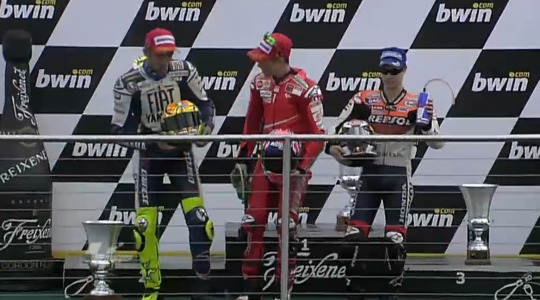
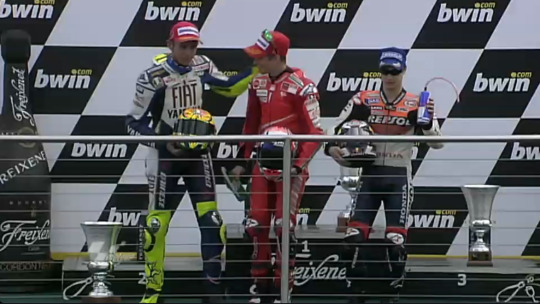
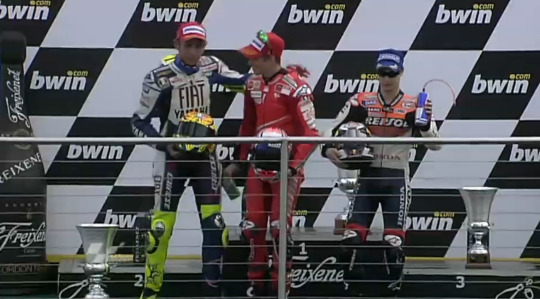
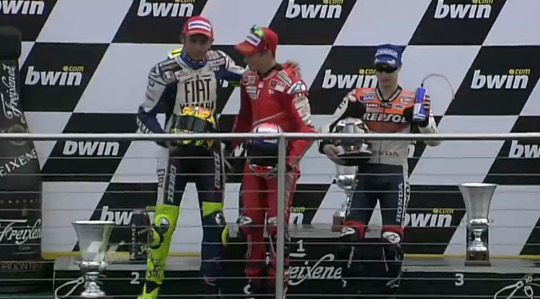
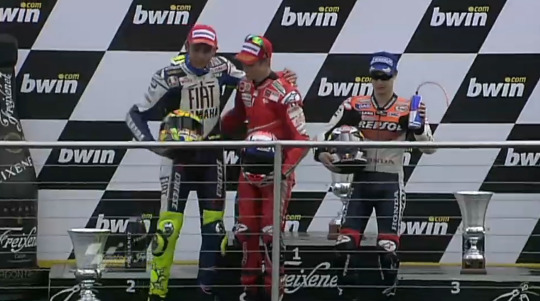
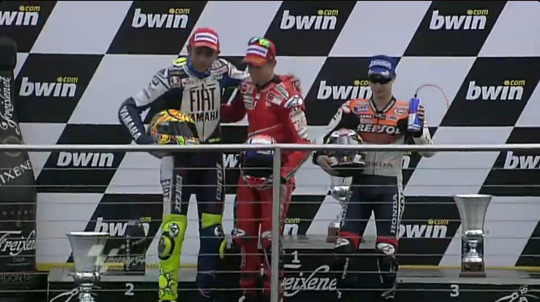


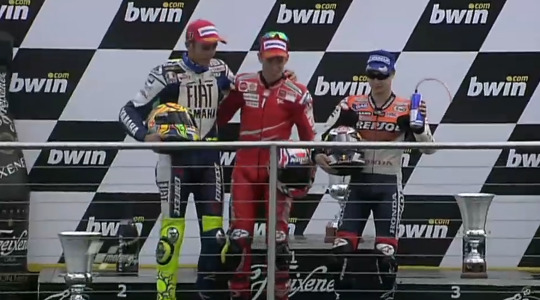

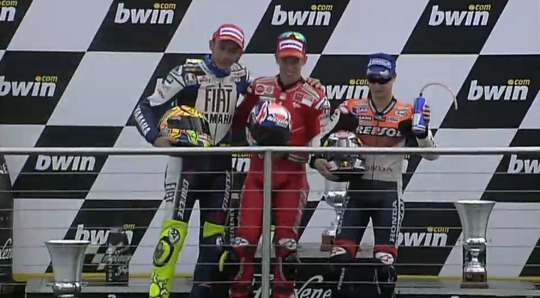
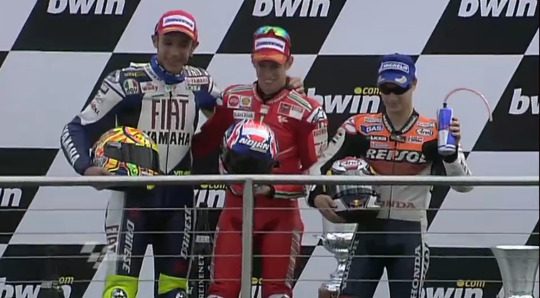
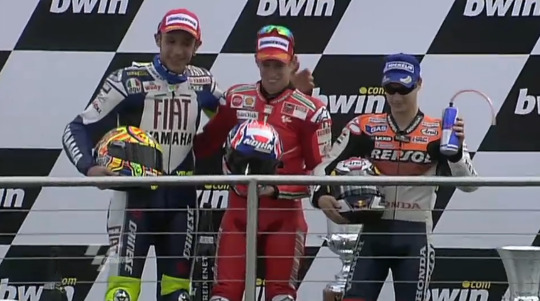
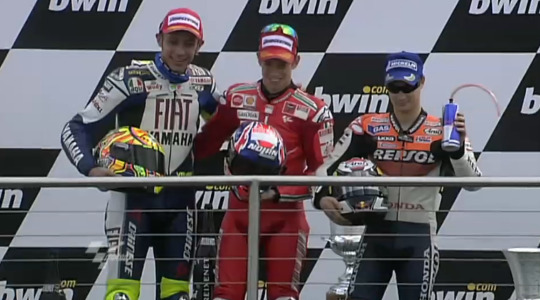
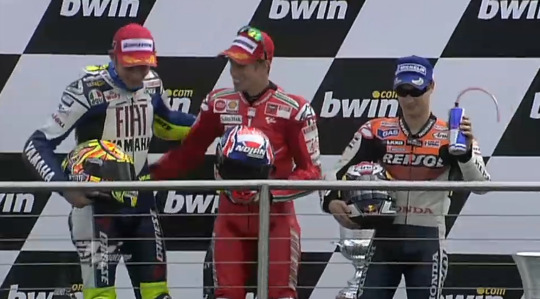
follow up to this post that provides the context of the donington 2008 race, and also some photos with more than three pixels of valentino and casey with their arms around each other
so. *cracks knuckles*. let's talk about jorge and valentino. if you want to understand the texture of the early years of that dynamic, there are worse places to start than checking out the bit of jorge's biography where he talks about valentino attempting to calm down the crowd at misano 2009

the post about that rivalry linked to above doesn't go into much detail about this passage, mainly because that thing was quite frankly getting long enough as it is. but the passage really does capture some key elements that give you a sense of what the vibe was like back then - including jorge loving the donkey ears and needing the world to know how much he loved the donkey ears. you've got jorge's desire to learn from valentino, acknowledging the skill with which valentino bounced back from a disastrous weekend, talking about how he can orchestrate a crowd. jorge's professed belief that there is nothing wrong with the crowd reaction as they are simply backing one of their own. this intense preoccupation with public personas, with fan perception, with what constitutes acceptable standards of conduct within a rivalry, how to engage in honourable combat, man to man and all of that... the air of pompousness, of earnestness verging on self-seriousness that is so central to young jorge's whole deal. and on valentino's end, it is important to pay attention to how he is willing to make gestures in the name of keeping the rivalry civil. in truth, he knows that he can still rely on the public sphere to make jorge's life rough. let's not forget, after all, that the way-too-online jorge was far more affected by spaniards talking shit about him on the internet on valentino's behalf - italians just don't matter as much because their partisanship is essentially already factored in. unlike at certain other stages of his career, however, valentino can throw in these little symbolic acts to calm the waters, to show he doesn't actually want to be jorge's enemy. they're just rivals, after all; they can behave respectfully towards each other. below all the sturm and drang and drama, valentino's approach to managing rivalries in that era involves a general reticence to allow things to get too nasty between himself and his new rivals. that will not always mean that the non-valentino side of those rivalries perceived valentino's behaviour that way - but obviously they are not applying the same standards. valentino's points of comparison are fist fights and curses. what feels excessive to him is rather radically different to where some of his younger rivals would draw the line
while jorge will at least outwardly claim he takes no issue with the hostility of the fans, casey takes a rather different approach. it is one of the biggest themes of his rivalry with valentino: casey having an awful time with the public and resenting valentino for it. valentino will not have been the only reason for how poorly the fans received casey - there are elements of casey's personality that would probably have always made him a tricky sell to the fanbase. still, the extent to which the public adored valentino and wished him to win above all others obviously and undeniably contributed heavily to the vitriol with which casey was met. (to return to jorge, he is the more clear cut example where his lack of popularity was a combination of different factors - plenty of fans already hated him for his antics in 250cc well before he was anything approaching a threat to valentino.) abusive fan mail, fans physically assaulting him when he was riding around on scooters, booing... the main country casey associates with that hostility is england. italians specifically don't actually ever really come up - probably in large part because there were plenty of ducati fans in italy who supported him even when fighting valentino. but the english fans? no such conflicting loyalties whatsoever. obviously, they loved valentino - and the sports culture in that country being what it was... well, that love could easily get ugly for anyone who posed too great a threat. (not to get into the ins and outs of british vs european identity but it is funny sometimes how casey talks about english speakers in the paddock As Good - "I only speak to english-speaking riders" he says in 2009 - and also european fans As Bad, but then the only specific european fanbase he ever properly complains about is the english. casey radically pro-european in essentially separating out the concept of 'english-speaking' from The English and also then treating The English as like... quintessentially european. anyways.) and for whatever reason, they had it in for casey in a way they never quite seemed to for any of valentino's other rivals. there's obviously also the deeply personal element where he has family in england, he moved there directly from australia as a teenager... on paper, this should have been a country that offered him support, or at the very least didn't actively hate him. it felt more like a betrayal - it's a similar dynamic to why jorge was particularly frustrated by the spanish fans not backing him. the english fans being so unkind to casey was a particularly bitter pill to swallow because he never would have expected it from them
casey obviously feels quite strongly that valentino should have done something about this behaviour and didn't. depending on how much stock you put into certain write-ups of races in britain over the years, it is at least possible that valentino quite deliberately made casey's life more unpleasant in britain. all of which would make it particularly interesting if valentino did go for a little bit of a symbolic gesture with casey too, like he did with jorge. during the race weekend of donington 2008, casey was having a rough time of it (well, outside of the actual racing, where he was slaughtering the field lol) and was as ever outspoken in his irritation. he tended to have plenty of complaints about donington whenever he went - not just with the fans but also the track and just, like, the vibe being off, wasn't really ever enthusiastic about the place. none of this stopped him from winning the race by a country mile, of course. back then there were still track invasions after races, which is a safety nightmare at the best of times - but it was worse for casey, who talks afterwards about the "abuse" he got from the crowd on that lap. which does make you pay closer attention to how valentino catches up, darts ahead of casey, and basically leads him quite closely through the worst bit of the crowd to parc fermé; it's something that is remarked on in the commentary, how valentino has essentially gotten casey to follow him on their 'shaky' cooldown lap
here you have the traditional post-race thumbs up and shake of hand
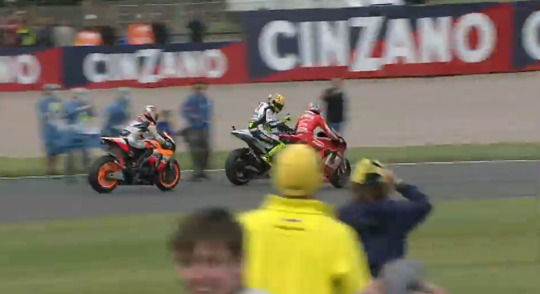
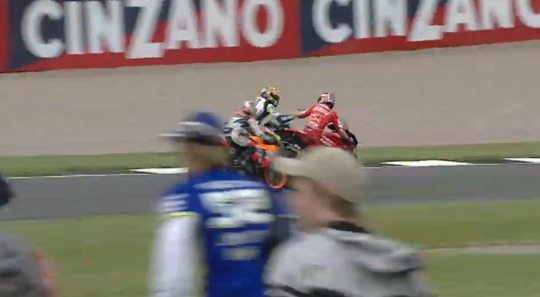

and then a few moments later, the densest part of the crowd
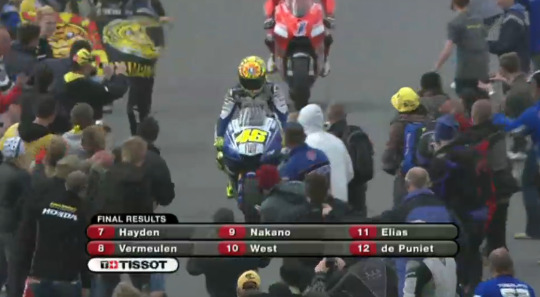
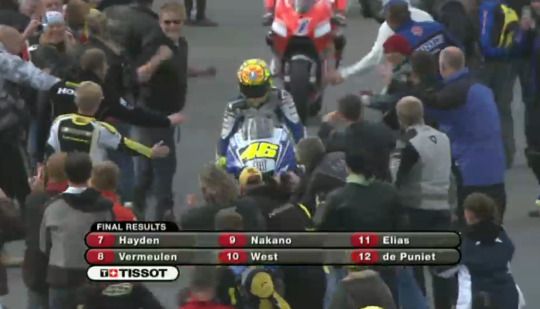
deliberate gesture to ward off the worst of it by essentially providing a line to follow to casey, or just a coincidence?
then you have the podium, where... well, you can barely ever actually hear booing on the broadcast for any race lol, dismal sound quality, casey definitely complained about it after the race so we know it happened. but having turned up the volume all the way, in the process permanently damaging my hearing - I'm fairly confident I can hear something that sounds vaguely like jeering and boos turn into what is definitely louder cheers when valentino puts his arm around casey, as depicted at the top of this post. I have watched way too many valentino podiums over the years, and I will say that a full arm around the shoulder isn't exactly common from him. amateur body language analysis corner, but there's something interesting in how valentino doesn't actually meet casey's eyes while he's doing it, looks straight ahead at the crowd while putting his arm around casey - there is obviously something quite performative about it, something quite pointed, something the crowd immediately picks up on and responds to... hold, hold, hold as they get the photos done, pat pat on the back, and then valentino lets his arm drop. casey of course reciprocated with his own arm vaguely around valentino, and he does also bust out the full grin right at valentino at the end there (you can see it if you lean really close to your screen). which the amateur body language analysts might conclude indicates appreciation for the gesture
now, look, I have fuck all reporting and only a few forum posts to back up what essentially amounts to squinting at footage of a race you've watched for the nth time in order to induce motorcycle racer-themed hallucinations. I'm about 50/50 on the cooldown lap, that might just be reading too much into it, but the podium does feel a lot more clear cut - and the combination of the two (plus jorge's testimony establishing that this sort of behaviour might be something valentino is vaguely inclined to do during this specific time period) is JUST enough to make me buy there's something deliberate there. your mileage may vary. also important to note that valentino's actual response in 2008 to casey's english fan situation was a big old shrug - aka some talk about how casey did complain rather a lot about everything to do with this race and also rumination about the ancient hatreds still raging between the anglo nations of the world to this day. he certainly was not willing to go on the record and admit to any responsibility for the animosity. given that valentino is not an idiot, he did obviously know that partisanship in his favour was in large part to blame for casey's reception in britain - not something, at the end of the day, he's going to be losing too much sleep over. still, he's aware of it, which is why the arm around the shoulder works the way it does, right? because he knew the crowd would respond to it. and it's just... these little symbolic touches that do matter when establishing the tone in 2008. valentino was willing to use pretty much the whole toolkit against casey to crack the toughest of nuts - hell, give him two more races and he'd bust out a hithertofore unseen couple of tools - but it was not quite the ugly fervour of past feuds at their peaks. instead, here we have someone simply playing the game and trying to judge how far to push things at any given moment, when it made sense to twist the knife and when it was better to play nice. valentino didn't actually want casey to hate him. given what valentino was willing to do to win motorcycling competitions (including not stepping in more firmly against his own fanbase, yes), casey coming to hate valentino was very much the end result of valentino's actions in those few years. which still does not mean that this was the intent behind valentino's actions; there are feuds of his where he is actively attempting to provoke his rivals, but this was not one of them (during the years where they were meaningful on-track rivals, which is just a blanket caveat I'm applying to the rest of this post). if casey came to hate him, then of course that was a price worth paying - but given a choice, valentino would generally opt for the cordial approach
this preference is reflected in the way he generally talked pretty positively about his dynamic with dani and casey in 2008, e.g. "the relationship between me, casey and dani is more normal, whereas biaggi was always saying bullshit". it's there in the descriptions of valentino using charm with his rivals, being free in his compliments ("when rossi gets beaten he makes sure to praise whoever has defeated him"). and, look: valentino was skilled at being a gracious loser, he did tend to throw some pretty effusive compliments especially in casey's direction when he lost to him, always preferring to bite his opponents harder from a position of strength etc etc. (still fond of this line from the guardian article about catalunya 2007: '"truly, casey is riding like a god," said the italian, who is rarely guilty of making an understatement.' please allow him. also, what if casey is just riding so well that this actually IS an understatement, what then.) yes, casey felt like valentino wasn't being particularly complimentary, that the compliments had dried up by the end of 2007. that's the thing about this rivalry, right, like you do have to remember that casey obviously isn't able to perfectly read valentino's intentions lol. valentino did still lob plenty of compliments casey's way - and actually said in 2009 that casey had started criticising valentino more when casey started winning after having been more complimentary before that, which is such a lovely example of both of them just being so fundamentally at odds that their grievances perfectly mirror each other. but the problem is that even if valentino was still saying nice things about casey, 1) it's human nature to pay more attention to one insult than nine compliments - and casey is particularly susceptible to this, and 2) what valentino considers 'keeping a rivalry civil' looks completely different from casey's understanding of that concept. (at times casey would probably be better served applying a generational lens than a cultural one lol - there's a reason why some retired racers found it remarkable how nice valentino was about his opposition.) valentino cools off towards casey interpersonally as part of his working process in title fights, doesn't go out of his way to provoke casey but does want to apply pressure wherever possible using all the little tricks he can along the way. which is understandably received as active hostility by casey (who is also still extremely young at this point) - but that doesn't necessarily mean this was actually the intent. when valentino wants to make an enemy out of you, typically you do notice it pretty quickly
see too how both of them are willing to engage in the song and dance of calling a truce at brno 2008, with only a couple of barbed comments attached from both sides. casey had given valentino grounds to escalate the conflict in the aftermath of laguna (including obviously the 'I'm faster than him and he knows it' thing), but valentino more or less refrains from doing so. an arm around the shoulder to get the crowd to give it a rest, accepting an apology without too much fuss... smiles and jokes and plenty of civility in-person... there have been valentino feuds that are considerably easier to spot at a distance, such is the interpersonal rancidity. all this while valentino is concurrently stepping up the on-track intimidation, but to him there is no contradiction there. valentino wasn't provoking casey for shits and giggles - he believed he had to do something not to lose the title that year. and... well, you can find his actions morally questionable, but it's a bit tougher to argue with the actual logic underlying valentino's behaviour. laguna 2008 isn't a case of valentino's need to create enemies expressing itself in attacks on his rivals for no good reason - it's a case of valentino being willing to do whatever it takes to win, even if it ends up making a new enemy. again: valentino is certainly using his entire playbook to exert pressure on casey - but at the same time, casey is not being treated like an actual enemy. at times, casey will have read a little too much outright animosity into valentino's approach... even though by his standards, valentino was trying to keep things reasonably cordial. it's just that he had a comically different understanding of what that looked like from casey. to understand that rivalry, you do have to get that a part of valentino's toolkit in those years was the interpersonal friendliness - a public willingness to perform civility. all you need to do is compare how the pair of them act around each other in the aftermath of that rivalry's biggest flashpoint (aka laguna '08) to how things play out in literally every single other valentino feud. (I know I started this post off talking about jorge and broadly speaking valentino does adhere to the same approach in 2009. but, 1) his relationship with jorge was a lot icier than his relationship with casey right from the start, partly because valentino just flat out disliked jorge, and 2) 2009 might star that rivalry's best duel but does not feature its major flashpoints, cf motegi 2010 and *checks smeared notes* something about a spanish conspiracy? - so it's not quite as notable jorge and valentino keep it vaguely polite.) from valentino's perspective, he escalates only as far as he has to. he's not emotionally invested enough to be all that offended by casey's response to laguna 2008, if anything can derive additional satisfaction from it... the race did what it was supposed to - he'll gladly accept a handshake of apology in its aftermath
sometimes, hygienic rivalry management involves giving off some mixed signals to confuse the opposition, to keep them guessing. it's a more uncertain situation than being outright enemies, one that makes it a little trickier for the opposition to parse how to approach that rivalry going forward, how nasty to be in response... valentino is happy enough to play this game when it comes to casey. the compliments, the public cordiality, the little gestures when he's feeling like it... charming off the track and vicious on it - all while dripping a steady dose of poison into the public discourse, attempting to make casey's life as difficult as possible. casey is the worst victim out of any of valentino's rivals of this two-faced approach, this disconnect between person and character casey himself is well aware of. even when the feud on paper should have been at its worst, valentino does not feel the need to cut casey off entirely. usually valentino does skew more clearly one direction or the other at any given time - usually he's at least a little more willing to show his hand, not mix pleasantries with cruelty quite so liberally. but he does not want casey to be his enemy. what a nuisance, right... can't like him can't loathe him certainly can't get rid of him
#dani as ever the only person in the sport adhering strictly to social distancing guidelines. ahead of his time#i do feel a teensy bit sorry for anyone who followed me for literally anything other than whatever the fuck this is#an intimidating number of asks staring back at me unblinkingly whenever i go to my drafts to analyse 20 blurry screenshots from 2008#//#//ht#2#brr brr#funniest relevant comment i found from that year posited that casey and valentino really liked and respected each other#which i think may be pushing it just a touch#uses as evidence this podium business and motegi 2008. delving into the body language and even the HANDSHAKE STYLE at motegi#only used by motorcyclists when they share a genuine bond apparently. who would have thought right#which does read like utter bollocks but who doesn't enjoy some borderline rpf in their noughties motogp comment sections
9 notes
·
View notes
Text
Halloween Special
First of all, I am one of those who have never, and I emphasize never ever, seen the Paul Lynde Halloween Special from 1976 in my entire life.
So I could easily be persuaded to claim that this production could only have any real meaning for anyone who sat in front of the television as a child and watched the recording on the original broadcast date. It should go without saying that this circumstance has more than often provided the decisive impulse for a lifelong fan existence, and I'm not talking about the one and only Paul Lynde, but once more about everyone's favorite band, of course.
And even if the television had happened to be switched on in my parents' house on 29 October 1976 and actually had US reception, I think I was still a little too focused on maintaining a reasonably steady balance between my dignity and my diapers as a newcomer to this material world to recognize what was going on in the flickering box with regard to my future beloved rock artists. If my baby carriage had been next to the TV. Anyway, so much for me personally.
But none of this should be a reason enough for me not to take on this challenge, after all, it's Halloween, the perfect setting for the likes of us. So let's sit down and watch together as Kiss impatiently storm the stage of the Paul Lynde Show and perform playback and short versions of their selected hits, all of which come from the then best-selling studio album Destroyer (1976).
Paul (Stanley), at the beginning, almost seems a little insecure and innocent like a young fawn, which nevertheless quickly gives way to his newfound Sturm und Drang post Destroyer performance extraordinaire. And it should, because after all, he has to lift two of the three performances almost exclusively on his shoulders, and the cameras hardly want to let go of him. And it should come as no surprise, because it's almost uncanny how young and handsome he looks. That can hardly be just the make-up.
Gene remains fully in rock n' roll jump demon mode, at least as long as the band performs, but thus only acts in the background and almost invisibly, see above, and when he is allowed to speak is pretty reminiscent of his appearance in Attack of the Phantoms (1978). But the fire, when spitting, is real in this case, and no low budget special effect.
For Beth, Peter gets to do what Eric Singer has been condemned to eternal fan death for years by all those old schooled real fans, namely sit at the piano and pretend he's actually playing the orchestral background music single-handedly while laying his voice over that shapely crust of frosting in real time. Gently, but equally anonymous. Maybe that was somehow for the best.
And Ace, well, Ace mostly just stands around stoically and bravely shakes his upper body left and right beyond his center, occasionally letting his tired arms hang out like a windmill, which may have something to do with his guitar playing. Ace is Ace and has always been Ace. What else can I say?
There's also one or two forced one-liners in the margins, devised by routined TV writers who, in the mercy of us all, we'd be better off saving. If Sean Delaney signed off on it, he must have been obviously pretty lenient. And that's basically it. More or less, because I only watched the Kiss segments, I just couldn't face the rest.
Only... those sequences with Margaret Hamilton, you know, the green witch from The Wizard of Oz (1939), reprising her role in full costume, almost 40 years after that fantastic movie. And there's just this one thing that still gives me pause, because of this little photo I stumbled across.
Did Gene get her laid or not? The witch. In full witch uniform and demon battle armor, of course. I mean, without wanting to be indiscreet, I think there should be reason enough to suggest that he kinda did (1).
What kind of sight would that have been?

Burn Witch Burn, Oo-Ooh?
Side Note:
(1) Anyone who has read Gene's biography Kiss and Make-Up (2001) should have no major doubts about this possibility. And if you had a culinary preference for sea food before, you might not have had any afterwards.
I highlighted the Kiss segments. The first includes Detroit Rock City, and the second Beth, some talk and jokes and King of the Night Time World:
Paul Lynde Halloween Special (1976) (1)
youtube
Paul Lynde Halloween Special (1976) (2)
youtube
#Paul Lynde#Margaret Hamilton#Kiss#Paul Stanley#Gene Simmons#Ace Frehley#Peter Criss#Sean Delaney#Paul Lynde Halloween Special#Halloween#Kiss and Make Up#2001#Destroyer#1976#Green Witch#The Wizard of Oz#1939#Detroit Rock City#Beth#King of the Night Time World#Roland Rockover#Youtube
4 notes
·
View notes
Text
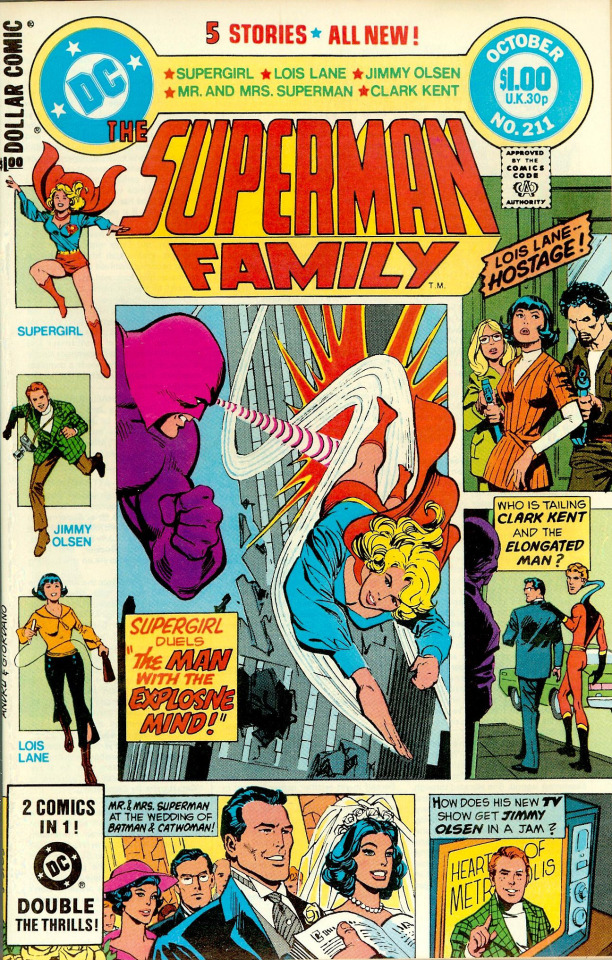
October 1981. In between the origin of the Huntress and the story that explained how the Earth-2 Batman and Catwoman married, Bruce and Selina's actual 1955 wedding was depicted in the "Mr. & Mrs. Superman" story in THE SUPERMAN FAMILY #211. THE SUPERMAN FAMILY, which outlived THE BATMAN FAMILY by about four years, was an anthology book originally created to consolidate the Lois Lane and Jimmy Olsen books (which hadn't been doing well individually) and the Supergirl strip from ADVENTURE. The "Mr. & Mrs. Superman" feature, little seven- or eight-page stories of the Golden Age Clark and Lois as a married couple in the 1950s, was one of the anthology's few highlights, although writer E. Nelson Bridwell could easily become distracted summarizing obscure continuity details rather than telling an actual story. This installment, entitled "The Kill Kent Contract!" has a silly framing plot where Lois accidentally overhears (à la SORRY, WRONG NUMBER) what she thinks is a plot to kill her husband at the wedding. It's overshadowed by the wedding itself, as seen here:

Given the level of emotional sturm-und-drang of the Huntress origin and the (later) "The Autobiography of Bruce Wayne!" this little story feels awfully sedate, although if you share Bridwell's interest in obscure details of old comics, it does have certain pleasures. if you're wondering: Selina's brother Karl appeared in a story in BATMAN #69 (February-March 1952), where he attempted to rip off Selina's gimmick as The King of the Cats; the fact that he's on parole here tells you how well that went. On Earth-2, Jim Gordon had only one kid, his son Tony, first seen in the Batman story in WORLD'S FINEST COMICS #53 (August-September 1951); on Earth-1, Tony Gordon was Barbara (Babs) Gordon's brother, who was killed a couple of years before this story. As for Alfred, Batman's butler went many years without ever being given a last name, although a 1945 story (in DETECTIVE COMICS #96) had him briefly use the last name "Beagle," which Bridwell obviously remembered. (The name "Pennyworth" wasn't established until 1969.)
As for the murder plot, Clark and Lois eventually determine that the target is not Clark, but Harvey Kent, the former Two-Face. In the original three Two-Face stories of 1942–1943, Harvey's last name was "Kent"; it became "Dent," probably by accident, in 1948, and that version stuck. Bridwell helpfully declares that the discrepancy is one of the differences between the Earth-1 and Earth-2 characters, although he at least resists the temptation to suggest that Clark and Harvey are related.
#comics#superman family#nelson bridwell#kurt schaffenberger#dan adkins#superman#batman#catwoman#clark kent#lois lane#bruce wayne#selina kyle#alfred beagle#commissioner gordon#tony gordon#earth-2#batcat#mr & mrs superman#golden age superman#golden age batman#batromance
12 notes
·
View notes
Note
neil clarified that it's not the fans he's upset with and that all he asks for is for people to either stop showing the leak or to at least mark it and the conversation around it as spoilers, which is more than reasonable. i still can't believe that what is possibly the biggest moment for the fandom has gotten out like this and that people are so insensitive when it comes to not putting up any warnings. i was hit by the image on twitter this morning and i'm still unhappy, hours later, about something that usually would've brought me immense joy, because the show means so much to me and i wanted to experience the season in the way it was intended. maybe just don't say that you're not going reveal the spoiler only to then talk about it in a way that leaves no questions. you can tag for potential spoilers on tumblr and there is also a read more option, so you're able to put things under a cut. it takes so little effort to be more considerate.
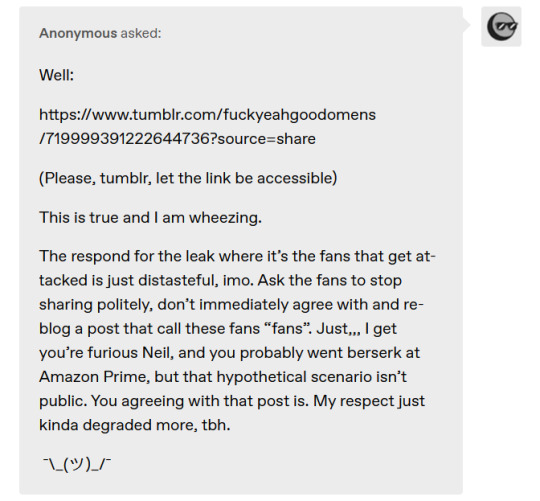

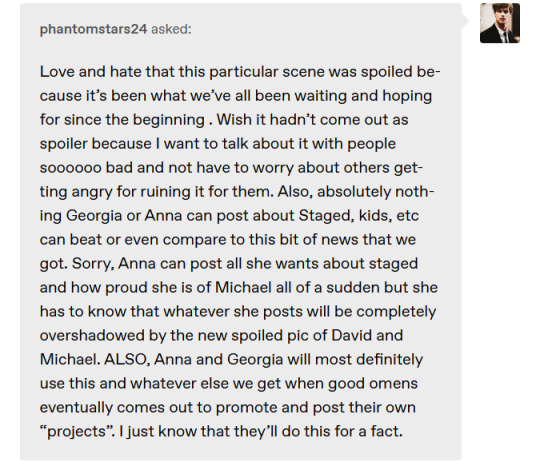
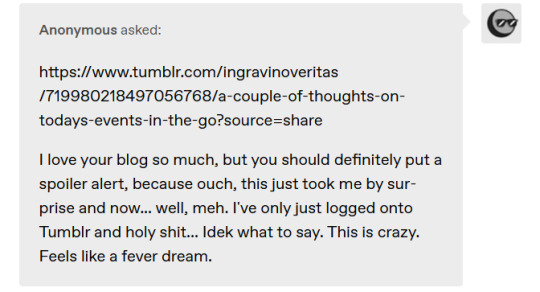
(Grouping all of the Anons that I got in response to my post together. Not included in this array is another Anon that I am not posting by request, but the tone is very similar to Anon #1, so that should give you an idea of things.)
Okay, so...wow. Obviously there are a lot of feelings around what happened, which is understandable. But what I'm a bit taken aback by is the seeming lack of personal accountability in a few of these responses. At no point was anyone obligated to continue reading my post if they thought a spoiler was about to be shared, and I find it peculiar that some folks are getting angry at me because they decided to employ critical thinking skills while reading my post (and also, why would you keep reading if you didn't want to see a spoiler but thought one might be forthcoming?).
There's also the notion that The Thing by its very nature is a strange thing to categorize as a spoiler because it shouldn't be surprising or a "twist" for these characters to be in a confirmed relationship...unless Neil was hoping to score brownie points with it after all of the "queer-baiting" accusations from last season. But blaming me for somehow adding to the sturm und drang around the spoiler news is not on, because while I realize I am an easy target (certainly easier than Amazon, at any rate), all of the above is also failing to take into account that I did not actually share the spoiler in my post.
That being said, I am certainly glad that Neil did indeed clarify (on Tumblr and Twitter) that he is not upset with the fans. The problem is, by the time he did so it was already too late, as the post he reblogged had received much more traction than the follow-up(s) and fans were already taking his word as chapter and verse and turning on other fans. This was also another point of concern, seeing how intense the parasocial relationship between some of the fans and Neil seems to be. As I've said previously, it is absolutely understandable for Neil to be upset/angry about what happened and we can, as fans, say that his wishes as the creator should be respected.
But where I saw things go way over the top was what you mentioned, Anon #3. People seemingly breaking down and falling over themselves to apologize to Neil, as if we are his friends whom he would have come over with a cup of tea or a bottle of wine to cheer him up after a bad breakup. So it was that particular response that I felt was really disproportionate to the events that occurred.
Anon #2, the link you shared does work, and I had to laugh at the highlighted comment, as well as Neil's original one, which now seems to have aged like milk left out in the hot sub-Saharan sun for an entire week. In a way, we can definitely say that Neil did warn us, and what he said came true--that if one hung around the official channels, little bits and things would be released into the wild. Amazon very much did fuck up, but it's hard not to find the hilarity (and irony) of them fucking up in the most Good Omens-y, "incompetent angel and demon losing the Antichrist" way possible.
To your point, Anon #3, the leak happened because a 2-frame clip was included in a compilation video that Amazon posted that included clips from multiple shows. But it's for this very reason that most fans didn't think or realize that it was a leak in the first place. So I think you could classify it as a poorly done promo, because whether it was intentional or not (and goodness knows I've seen plenty of theories floating around as to which is the case), it still generated buzz and discussion around the show, which is what promotion of any kind is meant to do.
As you said, however...in the end, is this truly going to make anyone not watch the show? I was away/nonstop busy last week and weekend, so I haven't really had time to process everything, but now that it's sinking in, I am SO incredibly excited. While, yes, it would've been lovely to learn this information in the context of the show and I do understand people who feel disappointed due to this, I genuinely cannot imagine how this news could make the experience of GO 2 less joyful, or why any GO fan would not watch the show because of it. I also have posts from as far back as a year and a half ago alluding to these developments only as a possibility, and I'd very much like to reblog some of those just because of how amazingly/hilariously well they have aged.
With all of that in mind, as I stated previously, any posts I do make from here on out that allude to the spoiler even slightly will be tagged as such (with the tag #go2 spoilers), and will be placed under a "Keep Reading" cut. Because I know there are folks who are dying to talk about all this, whose excitement may have been tempered somewhat in the wake of the fallout but who I am sure are feeling elated and full of anticipation now more than ever.
So those are my thoughts on the follow-up to last week's fandom implosion. Hopefully I've addressed some of the concerns people have, and while I know I likely won't change anyone's mind, I have plenty of other feelings and thoughts to share that I hope folks will stay tuned for...
#anonymous#phantomstars24#reply post#good omens 2#aziraphale#crowley#ineffable husbands#neil gaiman#go2 spoilers#trying to provide a balanced perspective#hopefully we can all chill out a bit from here on in#please let next week be better#fandom woes#discourse
12 notes
·
View notes
Note
If it's alright to ask, would you mind going into a lil more detail about Mario and Luigi's school days? Every single time Mario has a stray thought or memory about it during Expiate I'm just over here with the eyes emoji
Absolutely love seeing people's different interpretations of the bros' past and how it affected them later on in life
You may absolutely ask, this is actually a topic I am thrilled to have the opportunity to talk about :)
Buckle in, this one is going to take a while. :)
I originally conceived of Mario and Luigi's backstory before the movie came out, so it's not going to align. I think what the movie does is great and fun (although they really didn't explore Luigi's relationship with his family all that much, aside from Uncle Tony, may he stop infringing on my boy's space, please - which I thought was interesting), but that's really as far as it goes for me in terms of my writing.
My Mario and Luigi grew up decidedly in Bensonhurst in the 80s and 90s. They lived with their mother and father (and for a time, a grandmother who passed away when they were young) in a rundown apartment, their father a plumber (obviously) and their mother and off-again/on-again teacher and administrative assistant who, unfortunately, had a bevy of intensifying mental health issues and was eventually institutionalized upon their father's death when they were in their very late teens. (This becomes important later).
K-8, the brothers attended a Catholic school named St. Ephram's (which does exist in Dyker Heights - a short commute from Bensonhurst - and what I'm basing their early school days off of. Beyond the name and place, everything else having to do with the school is wholly made up). While the boys' father didn't really care for the whole setup, there were some other, more traditional members of the family that were insistent on it (mostly their mother's mother) and supplied the part of the tuition that wasn't covered by scholarships. (Inflation was also far less crushing back then. Oof).
Mario was actually a bit of a shy kid at first, minding all his ps and qs, never getting into trouble. Luigi was more of the live wire, a bit of a blabbermouth as a kid, but also gawky and just different than his peers, and that gap only continued to widen as the boys hit the Sturm-und-Drang which is puberty.
At this point, Mario starts to bulk up and fill out his stout frame whereas Luigi continues to be a little more willowy and uninterested in sports and the like. This doesn't go over well with a lot of the other boys in school, on top of which, Luigi's anxiety starts to manifest as irrational anger because he's thirteen, hormonal, and a dumbass that has no emotional regulation to speak of. He also hates the school, super-hates religion class and that old bat Sister Catherine (and that's a whole thing in their family, when Luigi starts to refuse to go to Mass), hates the popular bully Sal Imbargiana with a burning passion, and his mouth tends to write checks his ass cannot cash, leaving Mario in the position of bodyguard more often than he wants to be, which is definitely a bone of contention between the boys as Mario is also thirteen and a hormonal dumbass and wants to look cool for his friends and his nerdy, robot-loving little brother is anything but (again, this is way before nerd culture became a thing. All this being said, Mario will pound anyone who hurts Luigi into the ground).
This is exacerbated by their home life - their mother's worsening condition, their father being out at all hours of the day and night pulling in jobs and working for some not-always reputable characters (it's Bensonhurst in the 80s/90s. Enough said). On top of this, their father is well-meaning and he loves his boys, but he's a little old-school and he and Luigi are at constant loggerheads about something all the time as they just can't get on the same wavelength.
So around this point, in eighth grade, the incident occurs in Religion class (the exact nature of which I will actually get to at the end of Expiate, so stay tuned for that one) and Mario is fed up with his brother's intensifying antics and aghast at what he did (it's nothing terrible, by the way, objectively speaking. But it also would not have gone down well in that time and place - like, at all). And being dumbass thirteen year olds, they decide to settle this by engaging in fisticuffs in the school hallway, because that's a great idea, boys. Really using the one braincell there. Sigh.
It's at this point the grandmother who was pushing all of this dies, the scholarships dry up due to a school grant issue and the boys end up in different schools for high school. Mario ends up in a public school (FDR) where he actually flourishes socially and athletically (maybe not so much on the academics, even though he's capable, but he was planning all along to take up his father's business). Luigi busts his ass after the whole debacle in religion class, getting accepted into Brooklyn Tech because he wants badly to be an engineer, to do robotics and get a degree in engineering. (He's even willing to go all the way upstate to Albany, or, he can't believe he's saying this - Jersey - for college, if that's what it takes).
And like Mario, Luigi also flourishes, finally, at Brooklyn Tech, meeting peers with similar interests and finally being in a place where being a bookish nerd isn't a social death sentence. But this is also where the anger turns back into anxiety and starts to hit for real as he's finally in a position to lose something he wants so badly and he's no longer pissed at the world. (And unfortunately, that's exactly what happens. Their Dad dies suddenly of a heart attack in the middle of the boys' senior year - Mario's 18, Luigi's 17 - and their mom ends up out of the picture. The boys get screwed out of the family business by one of their father's partners and Mario has to scramble to take on as many plumbing jobs as he can and Luigi has to help, if only to keep them financially afloat. Luigi scrapes by the remainder of his senior year, and it's not even a question if he'll follow Mario. Of course he does. And with all the chaos, his anxiety worsens and Mario's protective streak intensifies as Luigi isn't a plumber, this wasn't what he wanted to do and he's a good enough engineer to get the basics down, but now he's stuck. This isn't ideal for either of them, but they make it work, downsizing to a crappy studio in Bensonhurst until one day, a few years later, they find this warp pipe and the rest, as they say, is history).
There are a lot of other factors I haven't touched on that get alluded to in many of my stories: the boys' relationship with their cultural Catholicism (important to both of them for various reasons); with their whole Italian-American heritage; the general tenor and mores of these neighborhoods and life in general in the 80s and 90s. I kind of get into it a little here if you are interested. I've had another short story cooking for a while that gets into the origin of their hats and explores younger versions of the boys that touch on some of these elements. Probably should finish that one of these days.
Anyway, YMMV, but that's kind of where I place the boys at growing up. Luigi, hot-headed but asocial and nerdy in a time and place where that was not really accepted. Mario, shy and solid, finally coming into his own and wanting to be cool. And a very complicated home life with well-meaning, but deeply flawed parents.
And to touch on movie Luigi for a moment - if I had to make one criticism of Luigi's character (aside from the lack of screentime), it's that I think he may have been portrayed as a little too passive and too dependent at times. I get that the brothers seem a little younger in this version, but even the cartoon Luigi of my youth wasn't so deferential to his brother. Again, I adored the movie and loved seeing Luigi's big moment (and he does show signs of that quirky sassiness we know and love in Mr. L), but I will say that it skirted the line of excessive, at times. I think a prison break scene, which I think at this point we can all agree was in an early draft, would have fixed that issue easily.
15 notes
·
View notes
Note
Maybe Drang can finally win Sturm over by dancing 🤔
I BELIEVE IN HIM. We have to believe it can help.
Totally not because i want to see him dance obviously, this is purely altruistic. Obviously.
0 notes
Text
this is such a cool post!!
a short piece that immediately came to mind for me and kind of fits the theme is Fürchtenmachen by Schumann (Kinderszenen, op. 15 no. 11). the title is programmatic obviously and i think the chromaticism right at the beginning creates a weird ghostly impression.
also, bit random but i've recently seen the development section of the first movement of Mozart's String Quintet in Eb Major (k. 614) being described as Sturm und Drang, particularly the sudden agitated passages with large melodic leaps and repeated 16th notes in the middle voices.
The Gothic in Classical Music History (1760s-1920s)
Intro Back in high school I fell in love with two things; classical music, and Edgar Allan Poe. I’ve always loved Halloween, October, spooky things, ghost stories, horror and slasher movies, etc. And I always loved finding classical music that was also spooky, or dark, or evocative of the same eerie experience of a cold and foggy October day. Thinking about these memories made me want to put together a short list of Gothic Classical music.
But what do I mean? There is no true “Gothic music” as in a specific movement in classical history, because the traditional Gothic refers to literature. Not all art movements have corresponding trends in all mediums. Even so I thought it would be fun to say, if there was such a thing as Gothic music, what would that include?
18th Century
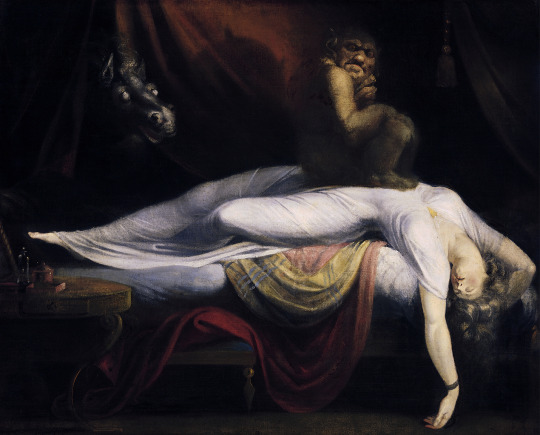
John Henry Fuseli - The Nightmare (1781)
Music of the 1760s-1790s, corresponding with the first wave of “Gothic Novels” in the English language. Some names in this era include Horace Walpole (The Castle of Otranto), Ann Radcliffe (The Mysteries of Udolpho, The Italian) and Charles Brockden Brown (Wieland). The closest we have to music of this same era would be in the Sturm und Drang style. Sturm und Drang (Storm and Stress) was used to describe music written in a minor key that was restless, agitated, intense, emotional, and more extreme than the typical expectations for restraint and lightness/clarity, music that aristocrats in powdered wigs and velvet and lace could relax with. Strong changes of emotion and more emphasis on subjectivity, reflected by sudden modulations and pulsing rhythms.
The most famous piece that I associate with Sturm und Drang is Wolfgang Amadeus Mozart’s “little” g minor Symphony no.25, K.183 (1773). It is famously used in the opening of Miloš Forman’s Amadeus (1984). It is a fun piece, and that opening movement is full of fire, and probably the young Mozart having fun (he wrote it at 17. If you ever want to lower your self esteem, look up what music Mozart wrote at your current age.). Another major work would be Joseph Haydn’s “Farewell” Symphony no.45 (1772), written in the very unusual for the time key of f# minor. And of course, even though he comes later, anything Ludwig van Beethoven published in a minor key has a lot of muscular passion to it, and his early/classical era of the 1790s is no joke. Check out the final movements of his Piano Trio no.3 in c minor and his Piano Sonata no.1 in f minor, or his most famous early sonata, the Pathetique.
But if the Sturm und Drang style and Gothic genre also emphasize the disturbed and the psychological, we can include programmatic works that do the same. Mozart’s opera Don Giovanni (1788) has an incredible moment in the finale. The sociopathic hedonist is confronted by the ghost of the man he murdered in the first act, who possesses a statue and confronts Don Giovanni with his sins. Don Giovanni doesn’t repent, so he is dragged into hell with a chorus of demons. Always a good reminder that Mozart wasn’t the eternal child who wrote pretty melodies.
19th Century

Caspar David Friedrich - The Abbey in the Oakwood (1810)
Music of the early 19th century corresponds better with Gothic fiction because Romanticism in art brought greater interest in the supernatural, in the subjective, in emotional reactions to the universe… major names in fiction include the poetry of Lord Byron (Darkness), Mary Shelley (Frankenstein, The Last Man), and Sir Walter Scott (The Bride of Lammermoor). Greater emphasis is put on the anxiety of the unknown, supernatural fears beyond our control.
Of all Franz Schubert’s songs, Erlkönig (1815) best exemplifies the Gothic (and this is a bold claim because I only know about a fraction of Schubert’s extensive song output). In it, a father and son are riding on horseback. The son is sick with fever. As they ride, the son cries out that he can hear the Elf King calling out to him, some evil spirit or demon that wants to take the son’s life. The father tries to calm him down, but the Elf King gets closer and closer. By the time they reach home, the son has died. Was the Elf King real? Was the son hallucinating from fever? How literal should we take this text? The ambiguity of subjective experiences and how we interpret and understand reality is a major theme in Gothic fiction.
Many famous German operas lean into the supernatural and magical. In this period we get Carl Maria von Weber’s Der Freischütz (1821), considered to be the first Romantic opera. In it, our main character Max who needs to win a shooting contest so he can be allowed to marry his lover, Agathe. He is given a gun that can shoot magic bullets by another forrester Kaspar (who has his own plans). Kaspar tells Max to meet him in the “Wolf’s Glenn” in the woods at midnight for more magic bullets. In the Wolf’s Glenn, Kaspar calls for a spirit, the Black Huntsman Samiel, to help him curse the other characters, offering Max’s soul in exchange. Making deals with demons/the devil was another fascination in Romanticism.
Legends of a diabolical nature were springing around great musicians. At the end of the 1700s, Giuseppe Tartini wrote his most famous composition, the “Devil’s Trill” Violin Sonata in g minor which is full of virtuosic passages. Tartini claimed that the Devil appeared to him in a dream, and that he sold his soul in exchange for the Devil to be his servant. He handed the Devil his violin, and the Devil “…played with such great art and intelligence, as I had never even conceived in my boldest flights of fantasy. I felt enraptured, transported, enchanted: my breath failed me, and I awoke” Source
Similar stories came about with violinist Niccolò Paganini, who astonished the audiences of the early 19th century with his (for the time) otherworldly technique, dazzling them with scales and leaps and scratches the likes of which you can hear across his 24 Caprices for solo violin. A young Franz Liszt was at one of Paganini’s concerts and he was enthralled and inspired to become the “Paganini of the Piano”. He too would dazzle audiences with his percussive intensity, glittering arpeggios, and dreamy modulations to possess women with the spirits of hysteria and other dated misogynistic diseases. Cliche to say but before Bieber Fever, before Beatlemania, there was Lisztomania.
The sense of Faustian bargains comes through in the pieces Liszt wrote after Goethe’s Faust. The Faust Symphony (1857) includes a movement for Mephistopheles, the demon/ the Devil that bargains with Faust. The Mephistopheles movement has no original theme, but takes and corrupts the themes of Faust and his lover Gretchen into a mocking tone. Later on, Liszt was inspired to write a tone poem “The Dance in the Village Inn” or Mephisto Waltz no.1 (c.1862). He also wrote it for piano around the same time. The story has Mephistopheles taking Faust to a wedding in a village and playing the violin so madly, the partygoers are intoxicated by the music and go off dancing in the woods. Emotions taking over and making one act irrationally was another fascination in Gothic fiction.
Liszt would go on in his later years writing a few more Mephisto waltzes, with a lot of forward thinking harmonies and piano writing, unfortunately not as popular. Mephisto waltz no.2 (1881) has moments that make me think of Debussy, and the third (1883) has glittering and ethereal moments. But the best example of Liszt’s interest in the Gothic would be his earlier concert piece Totentanz (1949), or Dance of Death (Danse macabre). In it, the piano and orchestra play out variations on the Medieval chant Dies Irae, always reminding us of the inevitability of death. The variations depict skeletons dancing wildly all while the Mephistopheles at the piano unleashes his seductive tones.
The Dies Irae chant goes across our pop culture, with one famous iteration being a synthesized version of passages from Hector Berlioz’s Symphonie fantastique that Wendy Carlos wrote for Stanley Kubrick’s The Shining (1980) after Stephen King’s novel of the same name. And it was Berlioz’s symphony that enchanted audiences in 1830 with new, titanic sounds beyond what orchestra music had been before. In the story of the Symphonie fantastique, an artist has tried to overdose on opium after feeling rejected by unrequited love, but instead he has a vivid drug induced nightmare where he is sentenced to be beheaded via guillotine, which was still a traumatic living memory for the Parisian audience. He then sees himself among ghosts and monsters during a witches’ sabbath, the lovely woman’s beautiful theme is distorted into a grotesque mockery, the Dies Irae comes back among the cackling. It was a new degree of imagination expected from the audience. Later, Berlioz would depict demons in Pandæmonium (the Capital of Hell in Dante’s Inferno) at the end of his Damnation of Faust.
Through the mid to late 19th century we get authors of Gothic literature such as Edgar Allan Poe, Elizabeth Gaskell, Emily and Charlotte Brontë, Nathaniel Hawethorne, and Victor Hugo. We also get two more operas that have Gothic themes. First is Richard Wagner’s The Flying Dutchman (1843). In this opera, a ship on the North Sea collides with the Ghost Ship of the Flying Dutchman who is cursed to sail the seas forever, but is allowed to come ashore once every seven years and if he can find a wife, he will be freed. I’m sure you can guess how this opera ends. The overture is often played in concert for a condensed version of Wagnarian thunder and romance. The next important opera is Giuseppe Verdi’s Macbeth (1847), because Shakespeare was being revived and translated in different languages across Europe and Verdi loved his plays. In the opera, Macbeth comes across a chorus of witches that foretell his success and downfall. He is too ambitious and goaded by Lady Macbeth, plans to take the throne through deception and murder. Lady Macbeth is later haunted with phantom blood on her hands which only she can see. And Macbeth succumbs to his inevitable fate.
We also get two significantly “Gothic” pieces of orchestra music. They are both tone poems, which also reflects the concert goers’ tastes. The one that has always been a quintessential “Halloween classical” piece is Camille Saint-Saens’ Danse Macabre (1875), opening at the stroke of midnight (softly evoked by the harp), a violin shrieks out the tritone (the “Devil’s interval” which the Romantics thought meant was cursed by the superstitious Medievals, really it was an idiom for “hard to use in music”) and introduces ballroom music along with the clacking bones of skeletons dancing in the graveyard (evoked by the xylophone). The skeletons dance through the night until the rooster crows at dawn.
The other great Halloween concert piece is Modest Mussorgsky’s Night on Bald Mountain (1867) which depicts another witches sabbath, this time on St. John’s Night, a major holiday in Slavic Eastern Orthodox culture. Walt Disney’s Fantasia (1940) would help bring this poem to life with an animated phantasmagoria of ghouls and skeletal horses and other demons flying around the mountainous demon Chernoberg.
[Here I want to give a quick shoutout to Cesar Franck’s Le Chasseur maudit (The Accursed Huntsman), a tone poem about a Count who doesn’t go to church one Sunday, and instead rides around to whip peasants for his own amusement, so demons drag him to hell. Not nearly as famous a concert piece as the others mentioned in this list but it has colorful orchestration so you should check it out.]
The initial idea for Fantasia was for Disney to repopularize Mickey Mouse by writing him into an animated version of Paul Dukas’ The Sorcerer’s Apprentice. The original poem by Goethe was a classic that Paul Dukas set to music in 1897. In it, we hear the Sorcerer leave his Apprentice to clean the floors of his workshop. The Apprentice uses magic to bring a broom to life so it can do the chores for him. The Broom mindlessly pours buckets of water all over the floor, and the Apprentice isn’t good enough with magic to stop it. He chops it up into pieces with an ax, but they regenerate into several brooms which go back to marching water in. The Sorcerer returns to clean the mess and scolds his Apprentice. This charming tale has a darker and more diabolically fun tone in Dukas orchestra.
20th Century
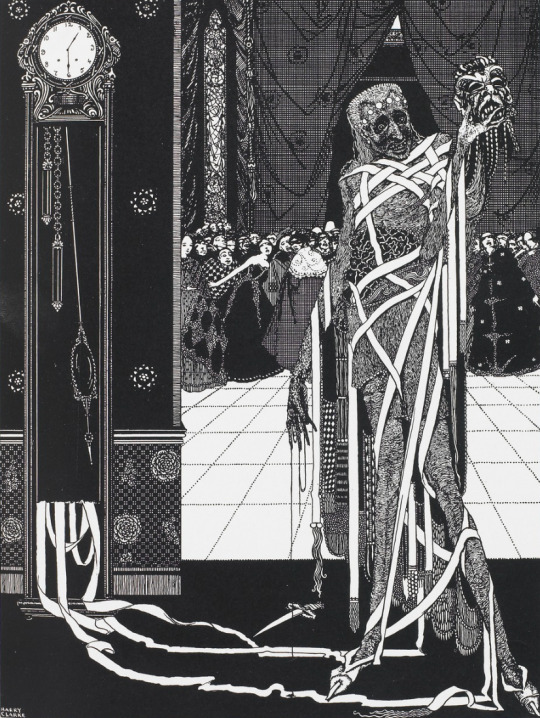
Harry Clarke - Illustration for "Masque of the Red Death" (1919)
In the same exact year of Dukas’ tone poem, we get Bram Stoker’s Dracula. At this turn of the century other major names include Gaston Luroux (The Phantom of the Opera), Robert Lewis Stevenson (Dr. Jekyll and Mr. Hyde), Henry James (The Turn of the Screw), Oscar Wilde (The Picture of Dorian Gray). At this time, there are a few more pieces that continue trying to evoke Gothic subject matter. One comes from Gustav Mahler’s Symphony no.7 (1905), sometimes dubbed “Song of the Night”. Two of the symphonies five movements are titled “Nachtmusik” (night music), the first is more in line with Gothic anxiety and spookiness than the second which is more like a serenade. But the most Gothic movement is the Scherzo which sits in the middle of the symphony and is like a Viennese ballroom full of dancing corpses and skeletons as waltz music decays with them.
A surprising example (at least, because of how relatively obscure it is) comes from Claude Debussy with parts of an opera based on Poe’s The Fall of the House of Usher that he worked on between 1908-1917. Not too much a surprise on the one hand because French translations of Poe’s work became popular and influential. On the other hand Debussy is more known for evocative sound pictures, unique musical colors, and subtlety. Perhaps he was drawn to symbolist and psychosexual interpretations of The House of Usher, the same interests that preoccupied him with his only finished opera Pelleas et Melisande. Roger Orledge reconstructed the opera and tried to stay true to Debussy’s style, so what we do have is passable and as shadowy and vague as his other orchestral masterpieces.
Maybe the hardest work to recommend (but I do recommend regardless, give it a chance) is a Modernist song cycle for chamber ensemble. Arnold Schoenberg’s Pierrot Lunaire (1910) uses freely chromatic atonality to give a demented color of psychosis experienced by Pierrot, personified version of a stock character for old Commedia dell Arte plays, a clown who over time became the “sad clown”. Maybe a precursor to the demon from Stephen King’s It, or the demented clowns and jesters that laugh at the madness of the cosmos across Thomas Ligotti’s short stories.
This was only meant to be a small overview of works that could fit my own view of the Gothic in music. There are more examples I could include, so as a hint toward today, I’ll end with a piece that was written about a century ago, yet sounds as if it could have been written today. Henry Cowell’s The Banshee (1925) is a short piano piece, so if you can, at least listen to this one. Instead of playing with the keys like you’re “supposed to”, Cowell asks the performer to drag their fingers along the wires directly. This creates disturbing reverberations and scratching sounds that tingle the back of your neck, that feel like the otherworldly cry of a Banshee.
Happy Halloween.
100 notes
·
View notes
Text
Plagued with lifelong lower gastrointestinal Sturm und Drang
Ever since a young lad irritable bowel syndrome
in my humble pinion wracked
lower abdominal area gurgled and ballooned gastrointestinal tract (similar to following Colonoscopy preparation slated for January 24th, 2024 at Phoenixville Hospital)
posterior issuing vis a vis borborygmus crooning in tandem and/or subsequent expulsion
eliminates fecal waste witnessing sprinting to bathroom, this scribe
(against time) and jet propulsion
of sphincter muscles'
spasmodic desperately raced
unpleasant symptom of anxiety/ panic attack
twas a stranger to this rhyme stir,
who now finds himself barrack cay did, and held hostage, where thoughts
about mooning doth not crack a smile, or baring derriere tubby more exact me up - matter of fact
no source of laughter, nada one ha intact (despite usual presence of chuckles
from this fan of good humor) high jacked for what seems a maternity leave
from all mothers tub be
thus envision, a bevy of pregnant gals
aching with cramps he
ving (times square of the hippopotamus)
with cervix fully dilated key
ping alert, when mother nature ready
to pull up all stops (via umbilical cord) to deliver nee, sans bundle of joy, followed
in quick succession with after birth re:
placental sack, hence
said effort to expel newborn
the closest scenario
experience ill suited to dance afflicting this anxiety prone
lovely bones, an all expense paid (seat of the pants)
accursed bane of proletariat grants no truce to attend finds me
pampered asper this rants.
Germane generic geeky guy
about one twelfth (knight) enroute to complete lxv luxurious Earth orbits
experienced chronic, demonic, physiologically hegemonic...
irritable bowel syndrome
without shadow of a doubt,
yet aforementioned plight
the following lines of poetry will not be about
problematic posterior plague.
After contemplating discomfort
linkedin with said medical condition,
yours truly realized aftermath
of Hurricane Ian concerning
those who weathered category storm
suffered a fate much worse
subsequently, I took a brief hiatus
typing lines of impossible
to understand questionable verse
challenging proclivity of one
yawping wordsmith being terse
yeah right you probably think
crowning glory upon
mine nonestablishmentarian literary endeavors
hands down majority of anonymous readers
would immediately qualify
his swiftly tailored prolix harried style unquestionably, obviously, and irreverently
imposing expansive vocabulary as perverse,
no doubt hurling expletive donned curse
at me with every stinging breath they took.
The previous writing endeavor
attached catchy title
at outset intent to brook
unspoken protocols analogous to river,
which overflows banks swallowing
entire metropolitan areas
categorized as biblical flood
believed to occur once
every five hundred year
exhibiting impact greater
than storied facebook
(as personal side note,
said creation a markedly popular
social media platform)
influencing great swaths of populace
allowing, enabling, and providing
user trademark friendly look,
which ineluctably draws innocent naif
into webbed wide world,
where coders fashioned
innocuous virtual pitfalls
many a stalwart devout
online interoper figuratively snagged
courtesy tempting virtual,
lock, stock and withal ingenious scandalous tailhook.
0 notes
Text
I had to read a shitty take about how bad the german FFXIV localisation is so as its Number 1 Fan have my favorite german translation detail:
The german version of Scholar's Expedient is called "Sturm und Drang" (which grants the buffs "Sturm" and "Drang") which was a historical german cultural movement (which fits Scholar really well) and is often translated to "Storm and Stress" (Drang can also mean "urge" but in this case its more often translated as stress) which fits the skill really well - It's such a good name for that skill in particular I was genuinely shocked to learn that that's a DE only thing
hiding this below the cut but i genuinely feel defensive over this game's DE localisation. and i don't want to put down the EN team, they're doing amazing work obviously, but it feels shitty when FR and DE are constantly treated as if they don't exist while EN is praised for things any other localisation would be hounded for.
like any other game wouldn't hear the end of it if they dared to change the writing to the degree that EN does it - but it's fine, no actually it's better that they do their own thing! something something but actually koji said that one time they write the game in english too so EN is its own thing, they are allowed! But when DE dared to change Zenos final lines? Prison. How dare they change the source material so much?! Don't they know that only EN gets to do that?? EN players could be missing out?!
Let's just say it: It sucks that I have to learn this game in two languages to talk about it online! EN people generally don't have to know the names of skills I don't even know in my language in two languages to talk about them. And they probably don't even know that the planet is only called Etheirys in EN! It's 2.5 versions against 1 for Ætheris(DE)/Ætherys(FR) (JP is Aaterisu, which I award .5 points for using an A even if Æ is not a japanese A sound). I guess EN was embarrassed to use the Æ all of a sudden even though they're the ones who decided to write the game in olden speak. (btw DE is not written in old speech (and thank the twelve for that i (personal opinion alert) can't even stand hearing it in trailers))
And no 'but the german voice over is bad!!' isn't a rebuttal to any of that. There's a lot of german self-hate in english speaking online spaces where any kind of german VO is automatically bad because it's not "as good" and I don't support that line of thinking - German VAs work just as hard and deserve our support! It's just that german gaming/anime VO (compared to other german VO genres where (when they don't hire youtubers) the quality is perfectly fine) is in a similar position as EN was five to ten years ago when Sub vs. Dub was still a thing and people absolutely hated any EN anime voice over:
All german gaming/anime VO is kind of meh and unnatural sounding because there's just not really a fully grown industry behind it in the way that even just other entertainment genres in german have it. Because you can't really release a movie or a TV series in Germany without german VO and expect it to sell well. Aside from special screenings with subtitles basically everything in cinema and TV has german voice over. The thing is you can do that with video games - as long as you provide subtitles it's perfectly acceptable to ship them even without translated VO! And even then it's already getting rare for games to receive german translations at all btw - compare that to the increasing drive of english speaking audiences to complain about the lack of complete voice acting for every single line in a game.
All of that to say I will protect the DE localisation with my life even if actually it's not all that good - which it is, they're doing a great job! I know it's different enough to actually be off-putting if you're used to EN's style, but I think it's a little more whimsical and cute :) I love the ways they translate job titles and stuff like that (we even have our own official job abbreviations!!) and they more often than not actually go back to older titles' official translations for recurring things!
But also enjoy what you enjoy. If it's not for you then move on, you have a broad array of choices to make your own fun without having to put people's hard work down. I personally always watch the german trailers at least once but even with all of the things above I am a JP Subs child at heart and will take JP VO whenever presented with the choice.
1 note
·
View note
Text
I read an article a while back. It would be excessive to call it a case study - more like a scientific diary. An anthropologist was allowed to be a fly on the wall of the investment wing of a major bank at the advent of ESG investment. According to their observations, labeling a fund or portfolio as "ESG" was considered a fascinating new way to bring money into the firm and had almost no impact on how the money was actually used. Maximizing returns was paramount, everything else was ad copy. Investments in obviously harmful companies was justified by comparing their performance to other companies. ESG information is convoluted enough it's easy to paint a narrative with any orientation.
So all this sturm and drang is over a movement that is, despite a lot of people's best intentions, a placebo. It's a carnival ride, and it goes nowhere.
Hey, yanno how Climate Change is a real thing that is tangibly, at this moment, affecting our world?
Well it turns out, the wealthy and their investment firms have been seeing the mounting evidence that oil companies have had for decades and are slowly starting to think more long-term about their portfolios in the face of rising sea levels, more extreme weather, and the myriad of ways climate crises are affecting…well. Everything. Maybe this means they invest more into sustainability, green energy, building more resilient infrastructure, or carbon offsets. Some of it, of course, is simple corporate greenwashing, but there are those that are taking this trend and packaging it into something called ESG (Environmental, Social, and corporate Governance).
Now some people would say this is predictable, even sensible. Just the good ol’ Free Market™ rationally responding to market forces and a changing world.
But those people would be fools! Insidious fools! For conservative sorcerers have come out with a new cursed phrase to explain this new market trend: Woke Investing.
What makes this investing “woke?” Well, much like how conservatives normally flounder when trying to define a word they stole from black people, “Woke Investing” essentially just means any kind of capital investment that they, the fossil fuel billionaire class and their sycophants, don’t personally profit from.
One of these aforementioned sycophants is Andy Puzder, conservative commentator, fellow at The Heritage Foundation, and former fast-food CEO. He calls this kind of so-called woke investing “socialism in sheep’s clothing,” further explaining in leaked audio of a closed-door meeting:
“My father’s generation’s challenge was the Nazis, who, by the way, were, of course, very proud socialists[citation fucking needed]. The challenge of my generation was the communists, who were, of course, very committed socialists. The challenge of your generation is ESG investing, and it’s more insidious than communism or the Nazis.”(source)
You heard it here first, folks. Not investing as much in fossil fuels is more insidious than the Third Fucking Reich.
As usual, the Heritage Foundation is putting their petro-chemical donor’s money where their mouth is. Bills are being proposed to blacklist banks that don’t invest in key state industries, such as West Virginia coal or Texas oil. Fourteen states have already passed bills to restrict ESG-type investing, with Florida Governor Ron “Bullies Kids for Wearing Masks” Desantis leading the charge.
In other words, Climate Denial has reached such a point that so-called Free Market Conservatives who claim to hate big government are trying to make it illegal for banks, investment firms, and financial institutions to make any financial decisions that acknowledges Climate Change is real.
126 notes
·
View notes
Note
do you watch current moto2 and moto3? and what riders are you keeping your eye on if so?
I sure do! not to be too rude to the premier class, but I kinda have to if I'm interested in seeing some actual 'racing' now and again these days. don't always watch them live, especially now that we've gotten to the flyaways, but I do at least try not to get spoilers before I actually watch them (not always successfully)
in moto3, I've grown fond of veijer - seems like a smart kid, comes across as quite a cerebral rider... had a tricky run of form of late but really I'm just interested to see what happens when he moves to bikes that should (hopefully) suit his frame better. obviously he'll be moving up next year, so we'll see how he gets on... I did really enjoy the piqueras performance from a while back, incredible mix of boneheaded and brilliant from a rider who just refused to lose on the day, very compelling to watch. as a rule ofc it's worth not to get too invested in the prospects of moto3 hopefuls, given that the switch to moto2 can be the killer... I mean, in terms of who I'm keeping an eye on, obviously alonso is the one to pay attention to. he's been a bit too good and too nice this year to be particularly interesting, so I can't say I'm all that invested as yet. missing in the sturm and drang department, seems like quite a happy-go-lucky kid... but the racing is fun to watch, the race craft is ridiculously good and hopefully he's a little less boring when he gets pushed more. has made the moto3 title fight pretty meh this year it has to be said
in moto2, I have a long standing fondness for alonso lopez, who kinda sucks but in an endearing way. still can't really preserve his tyres, is relentlessly aggressive, massively frustrating... but what's the point in rooting for someone who doesn't frequently frustrate you! idk if he'll ever hit good enough form at the right time to make the move up to motogp, his chances aren't great given his nationality but ah well. I'm not a massive ogura fan but I still have some residual fondness for that title fight nobody wanted to win in 2022, can't ever not root for a bottler. plus his refusal to ride for honda in motogp has been really funny, definitely enjoyed how he's managed to get himself a non-honda seat on the grid. also have to say, sergio garcia's really grown on me this year, first because of how good a job he was doing and now just feeling desperately sorry for how wrong things have gone for him. really hope he can regroup and fight for the title next year, get the chance of a seat in the premier class... might have been a sliding doors moment though, timing just a little off - it's brutal. oh and well, we'll have to see how the aldeguer situation turns out, unsurprisingly I'm now way more invested in him after he's flopped for most of the season lol. probably not quite got that acosta juice to him, but I do still reckon he'll turn out to be a fair bit better than this current moto2 season is making him look
but yeah, in general, I do really enjoy watching the races! mostly as a neutral, though it's fun to watch if you've chosen one or two guys to back in each class so that when they crash you can mute the feed in a fit of pique for a minute and mutter under your breath about how they've been robbed... you know, as you do
#i don't understand motorcycle racing well enough to be much good at talent spotting unfortunately#i think when you have someone as good as alonso is at his age then laws of sports dictate they are just very good. that's all i've got#//#brr brr#batsplat responds#basically to get me invested in you as an athlete you have to either#a) have an extremely tortured relationship with the sport; b) be actively evil; c) be a proper scholar of the sport; or d) kind of suck#ideally you need to have moments of all four to really live in my head rent free but at a pinch i'll always go for a lil bit of (d)#motogp's long been horrendous for lovers of hard working late bloomers which is a big part of why pecco is so dear to me
7 notes
·
View notes
Text
Strange Things That Happened In History Class
Cryptid Teachers
Professor Gadling had to take a moment. He really did.
It was that or explode into hysterical laughter right that very second and that really wasn't going to help his cause now, was it?
The paper he was trying to grade was supposed to be an essay on the suicide of Crown Prince Rudolf at Mayerling and its indirect effect on World War I. Instead, what he got was "Our Four Cryptid Teachers on Campus."
And a List, which deserved to be quoted in its entirety:
a. Professor Robert "Hob" Gadling - Probably knew Shakespeare IRL; explains why he has such a hate-boner for him
b. Professor Adam Pierson - has an actual motherfucking SWORD hidden somewhere in his clothes (maybe it's like Hammerspace?!!) and might possibly DUEL other immortals; maybe the OLDEST immortal because he talks about ancient EGYPT like he's been there, done that and worn the t-shirt
c. Professor Duncan Macleod - the OTHER sword-wielding immortal
d. Professor Nicholas Chevalier - VAMPIRE?!!! OMG?!!! Also, his Dad is legit creepy and we sincerely believe he's legit a vampire?!!!
Honestly, there was only one, sane, sensible way to respond to this.
Dustin, interesting essay choice there, lad, but I was rather expecting something about poor Crown Prince Rudolf and not speculations about my cryptid status. Incidentally, thank you for realizing that I'm not the Oldest Immortal around, yes, Professor Pierson wears his Ancient Egypt T-shirt with pride and yes, you'd do well to steer clear of Lucien Lacroix, that one gives me the willies.
You have a day to give me the right essay, so chop chop!
2. The Cat Thing
"So maybe his fursona is a cat, did ya ever think of that, genius?!"
"Ahahahaha, right, sure, Steve, he uses meows, purrs and trills like a legitimate language and the cats understand him - this is NOT a fursona thing my friend!"
"Also, Steve-o, I didn't think you knew about things like fursonas..."
"Eh, you've been around the Internet long enough, you pick up on some things, Wheeler."
"So Murphy speaks Cat like legitimately, actually speaks Cat, not just like us humans doing random meows."
"Yep."
"Score 1 for the Cryptid Candidacy! We're adding Murphy to the list."
"Actually, humanity knew how to speak feline once. The knowledge was lost, aeons ago. Isn't that right, Miette?"
"Meow!"
"I could tell you that Story, if you've a mind to listen."
"GYAAAAH!!!!"
3. Typhoon Morpheus
First off, Isabel didn't really actually mean to eavesdrop.
She'd submitted the wrong paper for the classwork they'd done today and while it wasn't as spectacular a mistake as Dustin Henderson's Cryptid List - it was still, obviously, the wrong paper. So she was just hurrying to fix things, although she was a little nervous, because Professor G seemed to be in a bad mood the whole day.
She was just about to knock on the door when she heard:
"Look, Gadling, you gotta do something. Caw!"
That voice sounded oddly familiar.
"Oh, Christ, what now?"
"Whatever it is you two did, fix it, for the love of Murphy. Do you see these feathers, man? I am soaking wet - it's been raining in the Dreaming and it hasn't stopped. Lucienne's already got all the rest of us trying to save the books in the Library from the flooding."
"Raining."
"Yeah. The boss thinks you don't love him anymore. So, boom, cue the rain. Thunder and lightning. Sturm und Drang - the works, you know?"
"Wait. Hang on, he thinks we've broken up?!!"
"Duh? Yeah?!!"
"Oh for Chrissakes, it was just a silly, ridiculous argument - I'm - hey, Matthew, remind me to kiss the stupid out of that idiot. After I yell at him. And kiss him stupid again."
"Reminder set, Other-Boss. Can we go now?"
Isabel told herself she was never, ever, going to speak of this to anyone - even if the fact that she had witnessed Matthew talking was probably enough to confirm Murphy's Cryptid Status on Dustin's stupid list.
4. Stranger Things
"Run this by me again, love," Professor Gadling said, in obvious bewilderment. "You're a Dungeon Master? What is that?"
"Not anything kinky, Professor G! AHAHAHA!" Dustin Henderson said in overly cheerful tones.
Murphy slanted the boy a look of wry amusement. "I think he understands that already."
"He's our DM for Dungeons and Dragons, Professor," said Will Byers. "It's a storytelling game."
"Ah, of course, a storytelling game, why wouldn't His Darkness the Prince of Stories be interested in that?" Professor Gadling said wryly.
"He's the best DM ever," volunteered Iggy Pop. "Like, the way Eddie went down fighting the demobats with Metallica, that was like, truly epic."
Murphy inclined his head in a regal almost-bow. "I can only but inspire. And I rather enjoyed young Eddie's performance. Truly something only a Master Bard could do."
"I'm still dead though!"
"Relax, man, we'll bring you back in flashbacks or something. Or maybe make you into a vampire!"
"Hey, you'd better - because I am this close to writing the Love Song of Eddie Munson and Steve Harrington and posting it on AO3!"
Professor Gadling knew when to give in. "Fine, you can use The New Inn for your session tonight. Just try not to wreck the place while you're off trying to fight the forces of darkness or whatever."
Murphy leaned over to drop a kiss into his hair. "We'll put all the breakables away before we begin our quest anew, dearest."
-end-
Footnote the First: Shortly after Dustin compiled his List of Cryptid Teachers on Campus, a new Professor joined the faculty, having retired from his former tailoring job at Kingsman. His name? Michael Percival Archangelus.
Footnote the Second: Dream of the Endless is not quite sure how he ended up adopting Hob's students and joining their D&D group, but he is quite charmed at their imagination and creativity and thoroughly enjoyed the idea of designing a villain formidable enough to test them.
Footnote the Third: Look, Dream still hadn't quite gotten all the nuances of a healthy relationship but he's at least figured out that minor spats and squabbles do not equate to breaking up and ending things forever. Hob's made sure of that. The kisses definitely helped.
****
Did I also just crossover Forever Knight, Kingsman and Stranger Things into this ridiculousness? Yes, yes I did. Nobody tell Neil.
Also, the "Michael" in this story is the headcanon Michael I came up with for the Lucifer show. Except obviously, this Michael isn't an evil twin douchecanoe but is an actual legit good guy... who uh.... spent a few years with Kingsman.
#the sandman#dream of the endless#hob gadling#dream/hob#dreamling#stranger things#highlander#forever knight#i crack what i want#bwahahahahaha#nobody tell neil
174 notes
·
View notes
Text
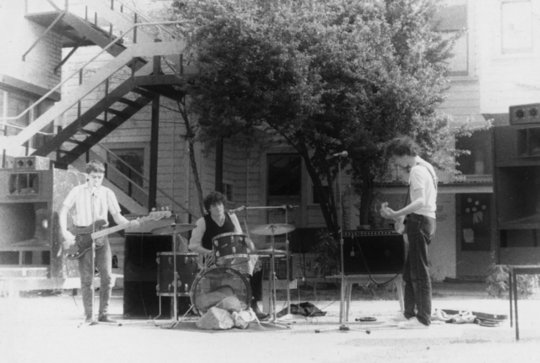
The Clean - Live in Dunedin 1982
We've been losing great musicians at a painfully steady clip over the past couple weeks — Christine McVie, Angelo Badalamenti, and most wrenchingly Clean co-founder Hamish Kilgour. The outpouring of love and admiration for Hamish since the tragic news broke shows what a positive impact he had on so many people.
Robert Scott: “He was the yin and the yang, the sturm and the drang, the bucket, the glue, the whole shebang.”
I always kind of loved that even though they were one of the greatest rock bands of all time, the Clean rejected most of the trappings of careerism, disappearing for years at a time, staying off of the treadmill for the most part. I think I heard Hamish say in an interview that they were "the band without a plan." Of course, that kind of dedication to music/art/creativity above all else comes with its fair share of difficulties; you always hope that musicians of that ilk are able to carve out a life for themselves somehow. Even though he was obviously struggling, I'm grateful that Hamish shared what he could while he could.
And of course, the wondrous sounds he made with the Clean, with Bailter Space, with the Mad Scene, with Tiny Ruins, solo and with many many other bands live on. And it's literally impossible not to feel better listening to the Clean, whose music is as life-affirming as it comes. For a limited-time treat, dig into this rare audience tape of the band right towards the end of their first run. Lo-fi for sure, but absolutely beautiful. That Dunedin Sound, ringing out for eternity.
Sign up for the Doom & Gloom From The Tomb Substack newsletter — Doom & Gloom delivered to your inbox every Friday!
32 notes
·
View notes
Text
ok this took way longer than i expected because i got sidetracked looking at paintings and reading poetry and just admiring the mv, but it's finally finished!! let's talk about
higher
✨
i'm going to draw your attention to a few things.
firstly, these verses from rime of the ancient mariner by samuel taylor coleridge, published 1834:
The harbour-bay was clear as glass,
So smoothly it was strewn!
And on the bay the moonlight lay,
And the shadow of the Moon.
The rock shone bright, the kirk no less,
That stands above the rock:
The moonlight steeped in silentness
The steady weathercock.
And the bay was white with silent light,
Till rising from the same,
Full many shapes, that shadows were,
In crimson colours came.
A little distance from the prow
Those crimson shadows were:
I turned my eyes upon the deck—
Oh, Christ! what saw I there!
Each corse lay flat, lifeless and flat,
And, by the holy rood!
A man all light, a seraph-man,
On every corse there stood.
This seraph-band, each waved his hand:
It was a heavenly sight!
They stood as signals to the land,
Each one a lovely light;
This seraph-band, each waved his hand,
No voice did they impart—
No voice; but oh! the silence sank
Like music on my heart.
secondly, this ivan aivazovsky painting, chaos (the creation), c. 1841:
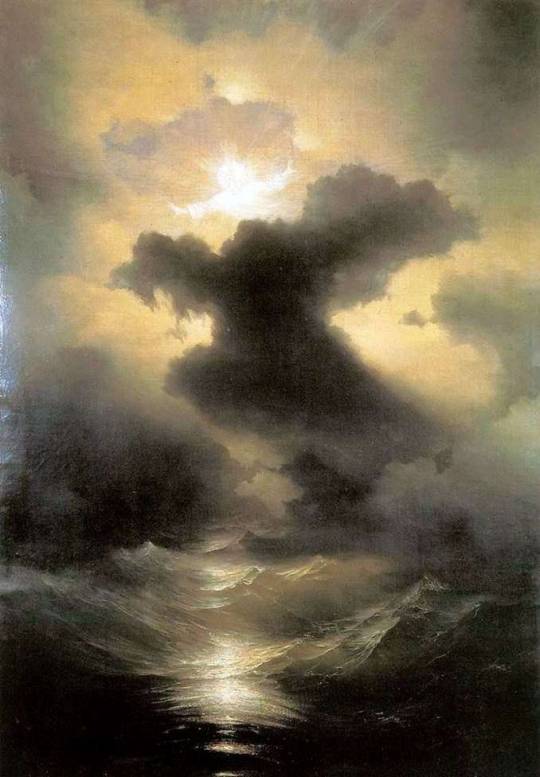
and thirdly, the memorial of percy shelley, who drowned in a boating accident at age 29, in 1822:
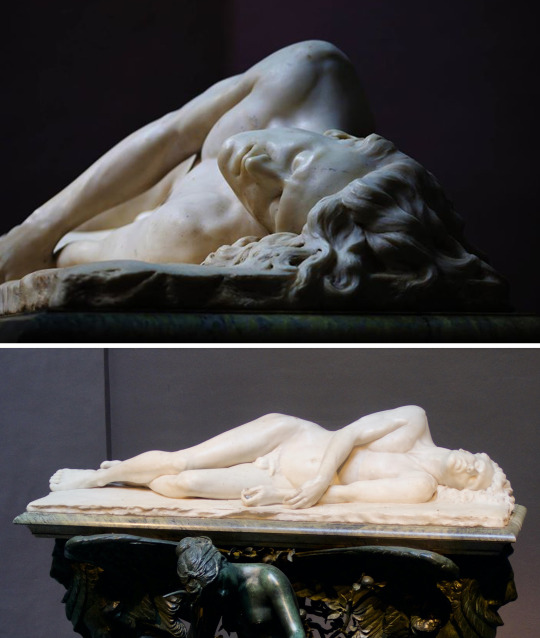
there's a common conflation between the romantic and the pastoral in the general cultural consensus because the pastoral a) has been around as an art term longer than romantic, and b) romanticism does use some similar imagery. but there is a key difference: the pastoral is specfically an idealization of 'the simple shepherding life,' often for high class and urban audiences who have no conception of the details of this life includes. one of the more famous examples is christopher marlowe's a passionate shepherd to his love, published in 1599:
Come live with me and be my love,
And we will all the pleasures prove,
That Valleys, groves, hills, and fields,
Woods, or steepy mountain yields.
And we will sit upon the Rocks,
Seeing the Shepherds feed their flocks,
By shallow Rivers to whose falls
Melodious birds sing Madrigals.
And I will make thee beds of Roses
And a thousand fragrant posies,
A cap of flowers, and a kirtle
Embroidered all with leaves of Myrtle;
A gown made of the finest wool
Which from our pretty Lambs we pull;
Fair lined slippers for the cold,
With buckles of the purest gold;
A belt of straw and Ivy buds,
With Coral clasps and Amber studs:
And if these pleasures may thee move,
Come live with me, and be my love.
The Shepherds’ Swains shall dance and sing
For thy delight each May-morning:
If these delights thy mind may move,
Then live with me, and be my love.
whereas romanticism is a more pointedly specific movement that was active from around 1800 to 1850, primarily focused on intense emotion and catharsis as the primary experiential output of an artwork. which most prominently manifested in a deep fascination and glorification of the natural environment and historical nostalgia. the movement sprung from the german sturm und drang (literally storm and drive/stress) period of the late 1760s to early 1780s, which was a direct reaction to rationalism and enlightenment. romanticism had similar impulses; it was also a revival of medievalism and a reaction against the looming urban sprawl and mechanization of the industrial revolution. a typical romantic poem from one of the originators of the english movment william wordsworth, composed upon westminster bridge, september 3, 1802, originally published 1807:
Earth has not any thing to show more fair:
Dull would he be of soul who could pass by
A sight so touching in its majesty:
This City now doth, like a garment, wear
The beauty of the morning; silent, bare,
Ships, towers, domes, theatres, and temples lie
Open unto the fields, and to the sky;
All bright and glittering in the smokeless air.
Never did sun more beautifully steep
In his first splendour, valley, rock, or hill;
Ne'er saw I, never felt, a calm so deep!
The river glideth at his own sweet will:
Dear God! the very houses seem asleep;
And all that mighty heart is lying still!
this romantic fascination with nature was underpinned by the philosophy of the sublime, generally agreed to be first treatised by edmund burke in 1756, the theory was also written about by kant and hegel. in the simplest of terms, the sublime is a quality of greatness beyond calculation, imitation, and human comprehension. the sublime is twofold; the greatness of the ocean is beautiful, but its power is also terrifying, and the experience of the sublime is to feel those two at once. to be in awe and also to be horrified of its ability to sink ships and drown a life in a tempermental change of tide.
let's take a quick detour to talk about
clothing
in the present day we have become much more lax thanks to the aesthetic movement in the late nineteenth century, but back in the early victorian period there are still highly structured rules about when and what clothing one can wear in public. and the clothing itself is also highly structured. anyone with a passing understanding of the victorian era knows about the whole flashing of the ankle thing and corsets galore, and it is true that the general day to day garments cover a lot of area. for men in particular, this manifests in no less than three layers in public at all times: shirt, waistcoat, and suit jacket, with a coat or mantle overtop in colder temperatures. this also includes a variation of a neck tie (depending on what year), hat, gloves, and any other decided upon accessories (this can also include a corset and other padded structural underpinnings). an important tangent to mention here is that this is the uniform of the upper classes, although the rules do apply to the lower classes if they wanted to appear 'sophisticated.' the working man's uniform was also shirt, waistcoat, trousers, but the difference here is in the textiles themselves; the colours tended to be much more drab, with less complicated patterns. obviously due to the price fabric itself, but also due to the labour of laundry. an indicator of class here is the white shirt itself and its pristine implications. (there is a longer conversation here about the invention of neckties and detachable collars and cuffs, but that's for another day). the silhouettes are very important to note here in the higher mv, as they are directly referential to the 'romantic poet' archetype of loose shirt and tight pants that we see in popular culture. but as i've just said, the reality is that men of the era were not dressed like this out in public. this look is essentially underwear; the implications are salacious. so where did this come from? well, we can blame it mostly on lord byron, who by all accounts was the first western 'rockstar.' notoriously called 'mad, bad and dangerous to know' by lady caroline lamb (a married women he publically had an affair with), byron was openly bisexual and deeply hedonistic with a lot of questionable habits, but his poetry was so popular that he was known to have women following him in the street and gathering in large quanities to see him at salons. and this was close to three decades before lizstomania. his close friends and contemporaries included percy and mary shelley, with whom he lived with abroad in italy for some time (this living arrangement resulted in the writing of both frankenstein and john polidori's the vampyre). byron's reputation was so eclipsing that the image of the lush poet lazing in his undergarments has become its own genre of romantic, slightly removed from the movement byron was writing in. it's also worth it to point out that there are no official portraits of byron dressed like this from the time. the visual assumption is somewhat apochryphal. now let's get into some specifics. a.c.e is not unfamiliar to this silhouette; as previously mentioned in this post i wrote about their styling, the boxy loose upper and fitted lower is their general mode for their styling because of its emphasis on legs. cactus was the most extreme example of this, and to prove my point, this specific silhouette is extremely common in classical ballet:
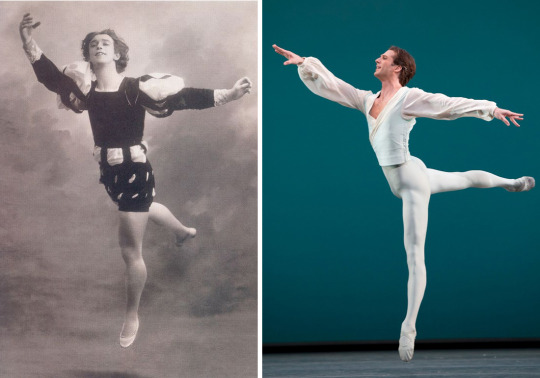
1. vaslav nijinsky, giselle, 1911 2. nehemiah kish, george balanchine's ballo della regina, 2011/12
higher fits very neatly into this same category: we have an emphasis on the legs through tightly fitted garments and also through light reflective textile, as well as a secondary emphasis on arm and shoulder movements with looser fit shirts. plus, the shirts are made from fabrics that have good drape and flow, and mimic the visual effects of water:

there are also several instances of scale patterning and wetlook hair styles, further elabourating on the siren theme. and the jewelry is the same, purposefully cut clear stones for oceanic sparkle or pearls, the gem directly born from water, as highlighting accents to specific parts of the body - namely eyes, hands, and torso:

the body jewelry also serves a double purpose in addition to being sparkly; it gives a semblance of shape to their torsos so their movements aren't totally lost in the shroud of their shirts, and it also invokes some of that salacious element that us as a modern audience doesn't necessarily perceive in the same way when we see a man wearing only a shirt. all of these points are especially prominent in the stage costuming. concerning the veils, these are an aesthetic choice following the theme of depicting water without actually using water. the song has a very breathless quality to it, and the lyrics directly make reference to water and breathlessness, so it only makes sense to have a physical manifestation of struggling to breathe.

now let's talk about
mise-en-scène
unlike most kpop mvs, I would argue that higher is not a spectacle in what we normally see spectacle to be. the overwhelming visual saturation of goblin (and the goblin remix) is more in line with what we expect, but how do you follow that, top it? the answer is that you don't. you aim for something with a completely different feel, which is exact what they did with higher.
the performing arts did not escape romanticism. the very start of the movement, sturm und drang, is actually named from a specific play written by friedrich maximilian klinger that premiered in 1777. the plays of the brief period are characterized by extreme and passionate emotions, and were siblings to one of the most famous genres of theatre, the melodrama. meant to appeal directly to the emotions of the audience using sensationalist plots and stock characters, the melodrama was the predominent form of entertainment in victorian england and gradually developed a specific form of its own. in this period we also start to see the development of 'stagecraft' into the recognizable form that it takes today. footlights, limelight/spotlighting, the separation of house and stage lighting, fly galleries, elevator platform mechanics, and the first (purported) western use of rear projection are all innovations of the late 18th and 19th centuries, as melodramas were known to have very intricate and spectacular stagings. and to go along with these stagecraft mechanics we see the rise in designated stage crews, which were predominantly off-duty sailors looking to make money. the rope systems that made up the fly galleries were very similar to that on ships, and much of the terminology and supersitions crossed over: this is the origin of the term 'rigging' being used for suspending set elements, and also the origin of the 'don't whistle in a theatre' superstition. as sailors communicated with whistle patterns on ships, the same system was adopted for changing scenery, and therefore whistling a random pattern could potentially drop a setpiece on an unsuspecting victim.
so with all this backstory out of the way, what is the very first full location we see? a stage, complete with forced perspective via the painted fabric legs (the side panels) and borders (the wavy upper panels). we even have a flat painted backdrop with a projection screen and hanging overhead lamps. there's also a second interior set, a desk in what looks to be a study of some kind. bit self explanatory on this one, taking the poet notion on the nose.

the locations have a bit of an obtuse arc, but it's there when you look for it. it starts interior spaces, where the ideas of sublime attempted to be recreated for the viewer. then it moves to transitory spaces; portions of nature isolated from a whole environment, interjections of human architecture into natural spaces:
(the white hut structure in the greenhouse is reminiscent of a skene (literally hut/tent), which is the structure at the back of the stage in ancient greek theatre used for the actors to change their masks and costumes. it was originally temporary, but slowly transformed into permanent stage architecture)

and then finally outdoors, into the sublime itself:
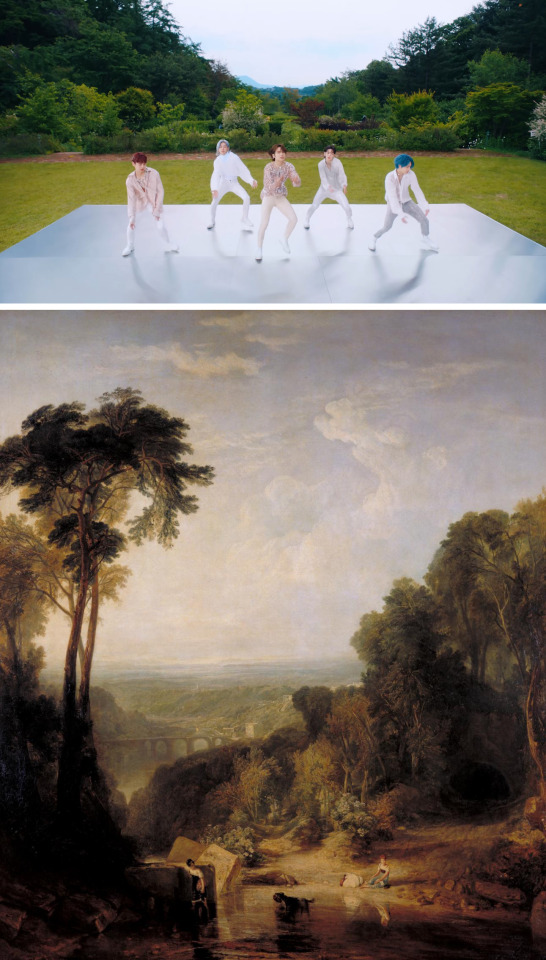
jwm turner, crossing the bridge, 1815
lastly,
lighting
there's a very clear lighting pattern here, primarily in light and dark. the base colour story is fairly simple complementary pairs; there's a lot of purple/red and green, and blue and yellow/amber, with everything relatively on the same tonal level. there are deliberate interjections of heavily saturated red for specific effect. there are also, most notably, a 'dark' version of all the sets. obviously as a reference to the eclipse that we see in the mv and in the concept photo series, but also as a reference to that darker undercurrent of the sublime, the upsetting, the uncanny, and the terrifying:

And the bay was white with silent light/Till rising from the same/Full many shapes, that shadows were/In crimson colours came.
#a.c.e#ace w#kpop analysis#group analysis#me - a staunch defender of kpop as valid spectacle: actually this one is a melodrama its meant to hit different#this essay is otherwise known as the quickest and dirtiest history of romanticism ever#i really should have pointed out that when i say romantic i mean romantic with a capital r#that probably would clear up some confusion but i have an aesthetic to maintain do not @ me#this is potentially the most pretentious thing i have ever written i am so sorry if this makes no sense#some of these connections are so tenuous who let me have opinions on the internet#did i write this as an excuse to look at the percy shelley memorial because i am obsessed with it as a piece of art? maybe#anyways read tom stoppard's arcadia if you want to know more about that#you should read all this with the caveat that the sublime and romanticism need to be deconstructed through a postcolonialist lens#because these theories are super colonialist about 'unclaimed untameable natural spaces'#when in reality most natural spaces are specifically architected by indigenous peoples in order to preserve and coexist with the ecosystem#this is may be more obviously applicable to american subliminal painting than european but it still applies#since the british were notoriously good at fucking up every kind of expedition ever#because of their lack of respect for literally anything and everything#and their inability to listen to anyone other than another white british person#see: history of the northwest passage#im a bad theorist and not caught up so i didnt get that deep into it because counter to the wordcount#i am not trying to write another dissertation#this is not as well researched as it could be but also im not reading burke and kant again#also yes byron the shelleys and polidori did just bang out the foundations for all of science fiction and romantic vampire mythology#in like three days because the all got bored during a storm and want to try and 'outscare' each other#also by 1840 like every prominent romantic poet was dead either from their own stupidity or tuberculosis#with the exception of wordsworth that motherfucker started the movement and then outlived it#text
17 notes
·
View notes
Note
I recall you mentioning that the guy Cloud is trying to impress with his dancing is voiced by Drang's VA and now I'm just picturing Danchou having to crossdress for a mission and for some godforsaken reason they turn to Drang to help and he flashes his sinister smile and says "Oh sure, sure, I'll help you. Provided you can beat me in a dance off!"
He can only do this when Sturm isn't around, obviously, so he's being peak silly about it
He helps you anyway, of course, and I can even believe that he'd do a passable job somehow
That's SUCH a funny visual. I don't know if I'd trust Drang with it but i want to see it. He'd rock those moves
My only supplementary info is that i want him to commit by dressing exactly like Andrea

I'm sure he'll do a great job. As things should be ;)
0 notes